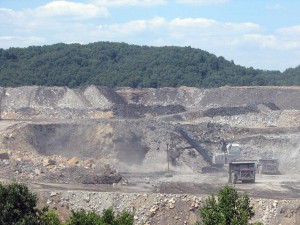Main points:
- C-reactive protein in blood among mining community members is elevated for adults living near surface coal mines.
- Counts of ambient particulate matter are higher in mining communities.
- Self-reported health indicators are worse in mining communities.
Overview Summary:
Study Background:
- All participants were non-smokers and non-miners without acute illness.
- C-reactive protein (CRP) is an inflammatory marker produced in the liver in response to cytokine signaling.
- High levels of CRP are predictive of an increased risk of cardiovascular disease and poor lung function.
- Coal mining is predominately a rural-based activity and is known to increase localized ambient particulate matter.
- The purpose of the current study was to test whether levels of C-reactive protein were significantly elevated in a rural sample living proximate to surface coal mining activity.
- Secondary goals were to gather additional evidence on levels of particulate matter and self-reported health for mining and non-mining community residents.
Findings:
- Outdoor and indoor air particulate matter samples were taken at 51 participants homes. Indoor particulate matter amounts per cubic meter were statistically significant for mining communities compared to non-mining communities. (Mean of 0.5 µm particle count per cubic foot in mining communities= 469,609. Mean of 5.0 µm particle count per cubic foot in mining communities = 3768. Mean of 0.5 µm particle count per cubic foot in non-mining communities= 151,018. Mean of 5.0 µm particle count per cubic foot in non-mining communities = 2715.)
- Outdoor particulate matter amounts per cubic meter were also statistically significant (higher) in mining communities than non-mining communities.
- Anything above 3.0 mg/L of CRP has been used to identify persons at risk for cardiovascular disease and other conditions; we found that the average adjusted C-reactive protein level for residents near mining operations exceeded this cut-point at 4.9 mg/L, compared to 0.6 mg/L in the non-mining control sample.
- Persons living in communities near surface mining had significantly elevated odds of a self-reported cardiopulmonary condition.
Conclusions:
- This paper shows evidence for biological impact among people living in mining communities.
- The missing connectors will need to measure environmental exposure, dose, and biological impact all among the same persons who live in mining communities versus controls who do not.
Policy Considerations:
- Prudent steps include more effective regulatory control over surface mining practices, or in the case of MTR, the complete termination of the practice altogether.
Funded By:
- Indiana University Bloomington was a medium for compensation for the contracted employees used to collect data, study logistics, and lab analysis.
Citation:
- Hendryx, M. ( 1 ), and J. ( 2 ) Entwhistle. “Association Between Residence Near Surface Coal Mining And Blood Inflammation.” Extractive Industries And Society2 (2015): 246-251. Scopus®. Web. 10 Feb. 2017.
Association between residence near surface coal mining and blood inflammation









